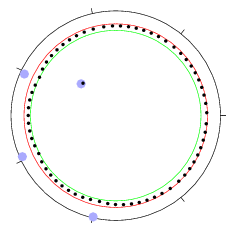The ∂ Steepest Descent Method and the Asymptotic Behavior of Polynomials Orthogonal on the Unit Circle with Fixed and Exponentially Varying Nonanalytic Weights
K. T.-R. McLaughlin
Department of Mathematics, University of Arizona, Tucson
P. D. Miller
Department of Mathematics, University of Michigan,
Ann Arbor
Abstract:
This paper develops a variation of the steepest descent method for Riemann-Hilbert problems, originally proposed by Deift and Zhou, specially designed to handle jump matrices that are not analytic. The method is applied to the problem of calculating the asymptotic behavior of orthogonal polynomials on the unit circle in the limit of large degree in the case when the measure of orthogonality does not have an analytic density. In particular, detailed asymptotics of the zeros are obtained.
Additional Resources
 A Mathematica notebook containing a program that produces figures
comparing the zeros of polynomials orthogonal with respect to weights
on the unit circle having jump discontinuities in high derivatives to
the analytical predictions for the locations of these zeros in the
limit of large degree can be downloaded here.
The program is called zeroplot (the notebook itself is called jumpzeros.nb). The image at the top
of this paragraph was produced with this program, and corresponds to
a polynomial of degree 104 orthogonal with respect to a weight function
having seven points of discontinuity in the third derivative.
A Mathematica notebook containing a program that produces figures
comparing the zeros of polynomials orthogonal with respect to weights
on the unit circle having jump discontinuities in high derivatives to
the analytical predictions for the locations of these zeros in the
limit of large degree can be downloaded here.
The program is called zeroplot (the notebook itself is called jumpzeros.nb). The image at the top
of this paragraph was produced with this program, and corresponds to
a polynomial of degree 104 orthogonal with respect to a weight function
having seven points of discontinuity in the third derivative.
This movie shows the birth of a spurious zero as a parameter in the weight is continuously tuned. The polynomial has degree 68 and there are seven jump discontinuities in the second derivative of the weight function throughout the deformation process. Click here for the same movie in QuickTime format if your browser does not show the movie below automatically.

In all images, the black circle is the unit circle in the complex plane, with exterior tick marks indicating the angles at which there exist jump discontinuities in derivatives of the weight function. The red circle indicates a degree-dependent radius beyond which there are no zeros for large enough degree. The green circle is a degree-dependent attractor for the majority of the zeros. The zeros of the polynomial themselves are shown as small black dots. Finally, the lavender dots are the zeros of a certain rational model function that is explicitly known; when these occur inside the unit circle they each attract precisely one zero of the polynomial, and when they occur outside of the green circle they have a repulsive effect on the zeros of the polynomial. The number of roots of this model function is one less than the number of points of discontinuity of the lowest order discontinuous derivative of the weight.
This material is based on work supported in part by the National Science Foundation under grant numbers DMS-9970328, DMS-0200749, and DMS-0451495 (McLaughlin) and DMS-0103909 and DMS-0354373 (Miller). Any opinions, findings, and conclusions or recommendations expressed in this material are those of the authors and do not necessarily reflect the views of the National Science Foundation.
McLaughlin also acknowledges the partial support of NATO Collaborative Linkage Grant "Orthogonal Polynomials: Theory, Applications, and Generalizations", grant number PST.CLG.979738, and Miller acknowledges the partial support of the Alfred P. Sloan Foundation.